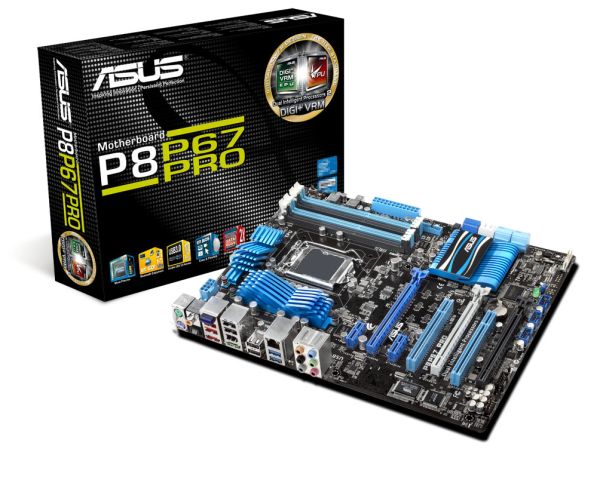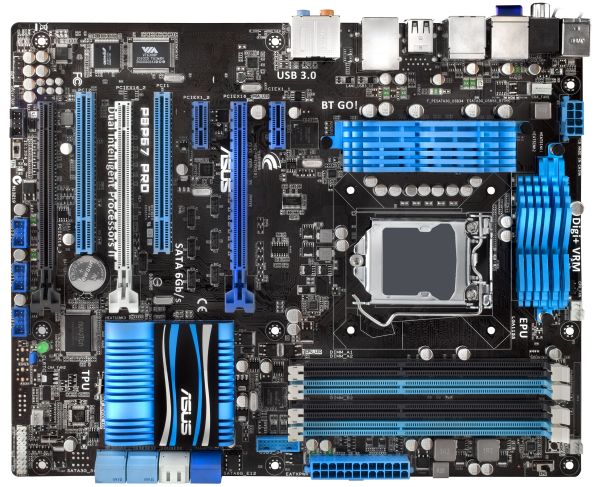A brief look at upcoming ASUS P67 Motherboards
by Ian Cutress on November 14, 2010 1:22 PM EST- Posted in
- News
- Motherboards
- Asus
On first inspection, this board’s aesthetic blue and black livery is impressive. The big blue heatsinks on the VRM, while looking good with a large surface area, intrude slightly on the socket, potentially resulting in restricting the orientation of high end air coolers.
Among the standard features you’d expect on a P67, such as the four dual-channel DDR3 slots, and four SATA 3Gb/s with two SATA 6Gb/s supported by the chipset, there is another two SATA ports, but it is unclear if these are for the RAID, 3Gb/s or 6Gb/s, or how they are powered, as they are not labelled and the chipset heatsink covers quite a bit. Two NEC controllers give two USB 3.0 ports on the back panel, and the possibility for another two via a header on the board connectable to the case, or to an ASUS USB 3.0 port box (as shown in the P67 Deluxe images). The Sandy Bridge platform on P67 relies on discrete graphics only, and as such there are no video out connectors on the back panel, but two PCIe x8 slots on the board itself (or one PCIe x16 if only one card is used). There is another PCIe slot available, presumably x4, for non-GPU duties.
The back panel itself is fairly standard – dual PS/2 ports for keyboard and mouse, S/PDIF out, six USB 2.0 ports, two USB 3.0 ports, two eSATA connectors, firewire, 5.1 audio and gigabit Ethernet. Also of note is the Bluetooth receiver, which is a nice addition, but the lack of a second gigabit Ethernet port, which by now we feel should be a staple on all high end boards and any board with the ‘Pro’ moniker, isn’t too pleasing.
On the board, we see two switches for TPU (TurboV Processing Unit) and EPU (Energy Processing Unit). The TPU is designed to monitor FET thermal temperatures, while the EPU will moderate power appropriately across the VRMs. Both can be turned on and off by the onboard switches, and presumably in the BIOS as well.
Speaking of switches, we’re disappointed that ASUS have not put easy-to-use power and reset switches on the Pro. Sure, not everyone needs them, but they are a nice addition rather than having to short two front panel pins with a screwdriver (when slightly tired, it’s never a good idea to accidentally short the wrong pins, unless you want to see some sparks).












53 Comments
View All Comments
duploxxx - Monday, November 15, 2010 - link
The Sandy Bridge platform on P67 relies on discrete graphics only, and as such there are no video out connectors on the back panel, but two PCIe x8 slots on the board itself (or one PCIe x16 if only one card is used). There is another PCIe slot available, presumably x4, for non-GPU duties.wow Intel is that all youc an design 1*16 or 2*8 nice one for a high-end board.....
strikeback03 - Monday, November 15, 2010 - link
These first SB chips aren't going to be the absolute high-end for Intel, see here: http://images.anandtech.com/reviews/cpu/intel/sand...So maybe there will be a further high-end chipset that supports more PCIe lanes for the true high-end SB once it launches.
Stahn Aileron - Tuesday, November 16, 2010 - link
I would think so. We (or at least I) haven't heard of any announcements concerning something like an X6x-series Chipset. (I would think X68 if Intel is keeping with it's chipset naming scheme since the 3-series.)If nevcairiel is correct regarding the all the arly CPUs coming with iGPUs, there's no real need for an X-series chipset board from Intel yet. Then again, that set of SB chips are coming with a new socket type. Maybe the high-end SB chips will come on LGA1366 and you can just re-use the X58 chipset. (Assuming Intel lives up to it's pledge of supporting 1366 for a while longer...Heaven forbid they release ANOTHER socket in so quickly again. I don't want to see an LGA1365 or something for high-end SB chips...)
DanNeely - Monday, November 15, 2010 - link
That's because like LGA1156 intel views LGA1155 as a mainstream platform. The high performance platform will transition from LGA1366 to LGA 2011 sometime around Q3 of next year.Stahn Aileron - Tuesday, November 16, 2010 - link
Ah, crap...I forgot about LGA2011...And now that I saw this post and read up on Wikipedia, there will be an X68 chipset for the high-end...Veroxious - Monday, November 15, 2010 - link
I agree about the price. I wish there was not such a big price differential between uATX and full ATX as well........... I hate uATX because they are usually very minimal and when the features are up to scratch the amount of PCI-E slots are lackingneoflux - Monday, November 15, 2010 - link
Any details on ASUS's P8P67-I mini-ITX board? Specifically, is RAID built in and what Wi-fi specs are built in i.e. b, g, or n and then 2.4 and/or 5GHz?As seen here and here:
http://www.engadget.com/2010/11/15/asus-sandy-brid...
http://techreport.com/articles.x/19982
neoflux - Monday, November 15, 2010 - link
Also, why does it have HDMI, DVI, and VGA if the P67 series doesn't support on-board graphics?DanNeely - Monday, November 15, 2010 - link
At a guess in addition to all the other integrated stuff itemized, there's a low end amd/nVidia GPU hiding somewhere on the board.strikeback03 - Monday, November 15, 2010 - link
Or the reported name could be incorrect, might be an H67 instead to take advantage of the graphics on the chip